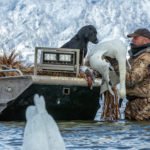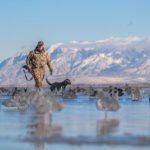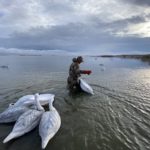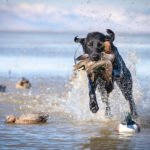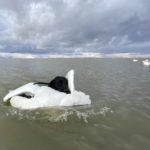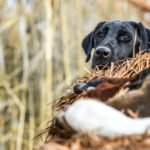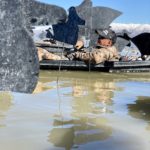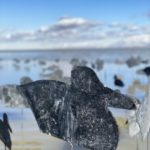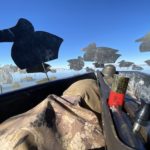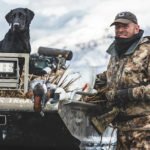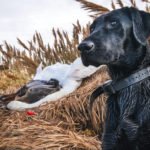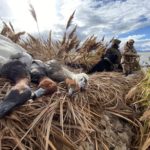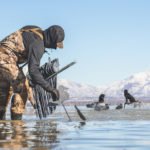Following a couple exciting days hunting swans and ducks together in Utah, Chad Yamane and Ramsey Russell share a couple cold beers before supper, talking about those memorable hunts. How are swans hunted in Utah, what gear is required and what pointers does Chad have for swan hunters? What was the weather like and why might the Utah swan season be abruptly closed within upcoming days, weeks? What distinctly Utah duck hunting technique was deployed to shoot ducks out on the Great Salt Lake and how’d this duck hunting method originate? What duck species did they shoot? What unique problem did they encounter? This episode is purely Utah, depicting a fun hunting you’ll not experience elsewhere!
Chad Yamane and Ramsey Russell Discuss Utah Swan Hunting and Unique Utah Duck Hunting Techniques
Swan Hunting in Utah
Ramsey Russell: Welcome back to Duck Season Somewhere from Utah. Road trip 2020 well under way. This whole road trip is kind of like a Forrest Gump thing. He ran to the end of the driveway; went that far, might as well go into town. Went that far, might as well cross the line of Alabama, and it just got out of hand. This whole road trip kind of started because, fortunately, I got drawn for a swan tag in Utah, so I came out to Utah to hunt with my buddy and today’s guest, Chad Yamane of Fried Feathers Outfitters, for a tundra swan. It just got out of hand. I went that far, I might as well just keep on going. How are you today, Chad?
Chad Yamane: I’m doing good. How are you doing today?
Ramsey Russell: Man, you make swan hunting look easy.
Chad Yamane: I always tell everyone that the hardest part of tundra swan hunting in Utah is drawing the tag, when you come with us.
Ramsey Russell: That’s the hardest part, and it is hard. I heard today that there’s something like 2,500 some-odd swan tags drawn and 5,000-7,000 applications for those tags.
Chad Yamane: Yeah, exactly. We have a point system here in Utah, kind of like a big game point system. About every other year, every two years, you can plan on drawing a swan tag when you apply for it.
How to Hunt Swans in Utah
Ramsey Russell: Well, I’m going to keep applying. I enjoyed it. What is the hardest part, other than getting drawn— Walk everybody through what it’s like to shoot a big, white bird in Utah.
Chad Yamane: Well, I mean we can go all the way back to when I first started, and probably most swan hunters started. When I started, twenty years ago, chasing swans, or even at twelve years old when we had tags— 90% of the Utah swan hunters go out, they walk the dikes. You find a day like today, where it’s blustery and windy and rainy, and you go out on the dikes. You hope that you catch a flock of them coming over you low enough, and you just pass shoot them. That’s what 90% of the hunters did, starting out. Probably a lot of the swan hunters still, today— I’ll bet 90% of them still do that. But just like everything, you want to get a taste of having them closer, or you see someone decoying them. So we started throwing out garbage bags. Throw a thing of white garbage bags in your coat pocket, some string and some weights, and you’d walk out there. It works really, really well. I think it still works relatively well, today. I think one of the reasons why is that, when you look at a garbage bag and the end of it, it almost looks like a butt-up feeder on a swan. I 100% believe that, if you took out a dozen of those today, it would work out well, and you’d probably still kill them. We started out with garbage bags; blowing them up with air, tossing them out there in the pond, and decoying them. That’s when I started kind of mouth calling them. It used to just be that “woo” like you hear, like we’ve kind of joked about.
Ramsey Russell: Every “woo” I’ve heard, hunting with you, sounded kind of like Jerry Clower calling up his beagle hounds.
Chad Yamane: Yeah, just “woo”-ing at them. “Woo!” Yeah, exactly. Just that loud “woo.” They just yell at them. Over the fifteen, twenty years I’ve been trying to decoy them, I’ve mouth called them. I’m horrible on a swan call, a manufactured one, but I’ve just tried to imitate them. It’s just like everything. I listen to them. I listen to their vocabulary. That’s where I’ve progressed to, today, when I’m mouth calling them. Then the progression starts into, “Well, okay, garbage bags work. Let’s paint up some of those 747 Magnums—other goose decoys—float those. Then, from there, Tanglefree came out with swan decoys. There’s been other people that have come out with swan decoys. It’s just progressed to where we’re at now, where we’re running thirty to fifty swan decoys and mouth calling them and trying to imitate and sound like the real thing.
Ramsey Russell: Three or four dozen swan decoys cover about an acre.
Chad Yamane: Oh, yeah. They’re huge. It’s like flipping a bathtub over and floating it, almost. Yeah, and we do a pretty widespread on them, too, because I’ve watched swans over time, and they really like their spacing. They like a big landing zone. When you’ve got a six-foot wingspan, I can understand that.
Ramsey Russell: What got me yesterday, watching some of those swans work, was just how wide— When they set up, they’ve got to go down wind and get back into position. What would you say, a quarter mile? A half mile?
Chad Yamane: Yeah, they’re going out two to five hundred yards to make that swing, right? They’re just such a big bird, but it’s really neat to watch them. When they want in, they come in. They’ll cup their wings up, they’re chewing off their wings, they’re craning their neck back, they’re making that ball just to get down. It’s neat. Of all the waterfowl that we decoy and get to hunt out here, swans are my favorite bird to decoy.
Ramsey Russell: On the one hand, if you get drawn for a swan, it’s one play. Unless you miss, but it’s one play. One swan. But on the other hand, it’s a hell of a show. I’m going to say, from the time that big gander—they call him a cob—hooked up, it just seemed like ten minutes. The minute you started calling, he got on a string, he looked at the decoys high, he fell back into the wind and started positioning himself like a jet lining up for the runway. It just seemed like we were watching it in slow motion. It took ten minutes. When he was a couple hundred yards off to your right, he was just locked up. That old neck had a big old bow in it. Big catcher mitt-sized black paddles hanging down like rudders. I’m like, “We’re fixing to kill this bird.” It comes right into the pocket. You pointed to that flock and said, “Right there,” and that’s exactly where that bird set up on.
Chad Yamane: That’s the cool thing with those birds. You try to do it with all waterfowl, right? You make those pockets. You create those landing zones. But with swans, they will just eat up certain zones. Once you’ve learned it, you can almost put them in. We did the same thing today. I had guys on the left side. I had just set it up, and, literally, they shot their birds at ten yards today. You just know what they’re going to do. You give them that pocket, an area that they can get in and get out, and they just eat it up.
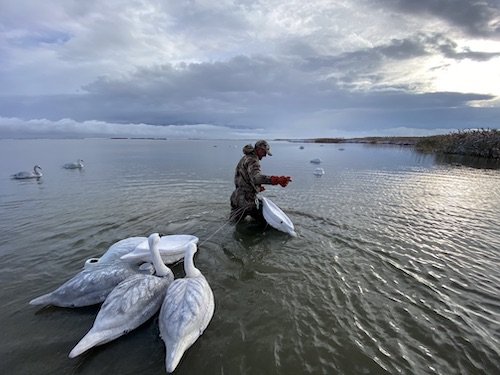
Where Swan Hunt in Utah
It’s about like anything, right? You traffic swans—and you’re just running traffic on them—or being in the spots that swans want to be in for the afternoon feed.
Ramsey Russell: What do you look for when you’re swan hunting in Utah? You’ve got millions of acres, and this is a major staging ground—the staging ground—for the Pacific Flyway population of snow geese. Which, I learned today, is two-thirds of the North American population, coming through here, but they’re not just everywhere. To put your clients on the bird, you’re selecting certain areas. I’m not asking you for a geographic location. Just, what are you looking for?
Chad Yamane: Yeah. So, generally, we target our swans in the afternoon.
Ramsey Russell: Why in the afternoon?
Chad Yamane: We’ll get into that. We generally will target them in the afternoon. With you, we got into them in the morning, but when I have clients come in from out of state, I want to give them every opportunity. My in-state clients, we’ll meet at noon, one o’clock. The flight is much better in the afternoon. When I have out-of-state clients and I want to give them as much opportunity as possible, the morning flight can be okay still, especially if you get a little wind and clouds. You know, we had snow when we woke up and got out there. But the afternoon flight— So what these birds do is, they will come out every afternoon to feed. They go up to the refuge, which is north of where we were at, and they will sit all day. After a short while—it doesn’t take 30,000 to 50,000 swans very long to feed out the refuge—they’ve got to go searching for food. When it gets cold and it’s iced up, they’ve got to go searching for open water and that food source. Every afternoon, they do that. Some afternoons are definitely better, but we are just looking for those food sources. We’re in the ponds that they’re feeding in all night long, so we’re targeting them in their food source for the afternoon.
Ramsey Russell: Sago pondweed.
Chad Yamane: Sago pondweed, exactly. So, yeah, we’re just targeting as they come off the refuge in the afternoon to feed. We’re just in the areas they want to be, or we’re trafficking them and we’re under them. It’s just a matter of being under a swan flight. It’s about like anything, right? You traffic them—and you’re just running traffic on them—or being in the spots that they want to be in for the afternoon feed. They’ll feed all night long, sitting in those ponds, and then, in the morning as hunters are coming back out, they’re generally getting booed back off. They’ll go right back to the refuge in the morning, and then do it all over again in the afternoon. They come back out.
Ramsey Russell: Do you think they—because I know you guide everything—do you think swans decoy more easily, or more consistently, than ducks?
Chad Yamane: I would say yes. It has to do with pressure. It’s just like any waterfowl. You give a waterfowl a little rest, or a little break, in pressure, and they definitely decoy more easily. These birds don’t get hunted all that much on their flyway. Montana gives out five hundred tags. Alaska allows them to harvest them, but not very many guys, probably, really pursue them or target them. I don’t know about that. Idaho doesn’t pressure them. We’re really kind of their first big pressure they really see, with our 2,700 tags. They just don’t get the pressure. They’re still not a stupid bird. Hell, they’ve lived for several hundred years. They’ve survived. They’re not absolutely stupid, but they are more naïve to decoying and calling and stuff like that. They definitely are more gullible than most birds.
Tip for Shooting Swans
Ramsey Russell: What is the number one advice you would give one of your clients showing up to shoot a swan? Because I hear stories when I talk to you and other swan hunters. Because they’re a giant— It’s like shooting a sheet of plywood.
Chad Yamane: Yeah. My biggest advice I always give to them, our speech in the morning or in the afternoon, always goes to: quit looking at their body, look at their head. Aim for the head. You’ve got to get out in front of him and lead him. We always reference a jumbo jet. You’re standing under a runway, and you’re looking at a jet that’s flying over top of you. It’s traveling at several hundred miles an hour, but it doesn’t appear that way because of the size.
Ramsey Russell: It’s an optical illusion.
Chad Yamane: Exactly. A swan is the same way. You put a true twenty-pound bird in front of a guy, and he doesn’t think that bird’s still moving at 25-30 miles per hour. He’s dead wrong. Every time they come up, I can always watch guys trying to catch back up to that bird. Then they end up looking at that body, a six-foot wingspan, and they think how chip shot that is. They put that bead on that chest; when they pull the trigger, I watch a puff of feathers come out of the tail end of that bird and the bird fly away. You hear me in the background, on video, screaming, “Lead them! Lead them! Lead them!,” because they just don’t give them enough lead.
Ramsey Russell: The head of that swan I shot is bigger than a mourning dove, slightly smaller than a green-winged teal. It’s a big old head. If you’re used to shooting ducks, or even geese, and you’re looking at that white bird; your math is off. Something about the conversion of scale in your brain, what you’re automatically programmed to lead, is off. You have to look at that head.
Chad Yamane: You have to look at that head. I think it’s just that natural tendency, too, for your eyes to focus on the biggest, brightest, whitest object. That motion and the wings and the big, white chest, especially if you get sun on them—it’s hard to get your eyes to pull off of that chest and those wings. You’ve just got to do it, though. There’s no way to kill a bird when you shoot them in the tail feathers. Their feet drop out. You’ve just got to get your eyes off it.
Ramsey Russell: They’re a big bird.
Chad Yamane: And they’re tough, right?
Ramsey Russell: Yeah, they’re tough.
Chad Yamane: Yeah. I mean, you put two solid hits on your bird, and they don’t just die.
Ramsey Russell: Like a hitman, double tap. Bam, bam. That’s the third tundra swan I’ve shot, and, every one of them, it’s like they died in slow motion. They don’t just crumple like a little duck that gets crushed. That was a solid hit. That bird was hit in the neck and head. It was a very solid hit, but, still, he doesn’t just wad up and fall straight down.
Chad Yamane: Yeah, they’re tough birds.
Ramsey Russell: I just feel like I need to keep shooting till his head’s flat on the water.
Chad Yamane: That’s what I tell everyone, too. If their heads are up, keep shooting, because I don’t want to chase that thing across the pond. Their feet are as big as your hand. They can get some distance on a dog and a boat before you can even get out of the blind to get them.
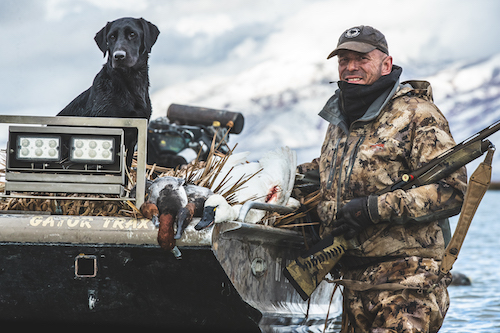
Utah Swan Hunting and Weather
Ramsey Russell: Let’s talk about the morning we hunted. We arrived a little late. You’d been looking at the weather forecast, and—for a Mississippi boy, especially—it was a white-out blizzard. It was like Armistice Day. I couldn’t see the edge of my truck, driving. I’m like, “Man, we’re fixing to get out in this mess?”
Chad Yamane: Yeah. We had that snowstorm that rolled through kind of early morning, dumped a couple of inches on us. The swans—really, the only thing that will keep them from really moving is some strong winds. When it gets above thirty miles per hour, they won’t fly in it. They’ll just sit tight. If you’re that big of a bird, it’s understandable why you’re not going to fly in it. Most birds, once it gets that windy, will just sit and tough it out. But like I say, when you’re swan hunting, you want some weather. It gets the birds moving. I’m looking at next week’s forecast. It’s going to be like 55º and sunny, and those birds are not going to move until 4:30. We’ll end up shooting them at 5:00. Those birds aren’t going to move till 4:30. They’ll sit all day long.
Ramsey Russell: Even with a dark moon?
Chad Yamane: Yep. They don’t have to move. When it gets cold, we get some snow, we get some weather—they’re looking for that food source. They’re such a big bird, they’ve got to feed. They’ve got to get out. They’ve got to find that open water. Like today, ice on the pond; the birds had to move. They moved all day today. It was just a good day. When you can get a little bit of weather, they move. They are active all day. They’re looking for that food source. They’re looking for open water. It just makes for better hunting.
Ramsey Russell: Well, if you don’t like the weather in Utah, just wait five minutes. Because when we were running down the slot, you were wide open in your mud boat, and I got a picture of you holding your glove over your face to keep the snow out of your eyes.
Chad Yamane: Oh yeah, the snow was smacking me in the face. Five minutes later, the sun was almost out.
Ramsey Russell: Yeah, we’re throwing out decoys, and it was just gleaming. It’s like a beautiful day, and the sun is shining, but that was temporary. You know what shocked me? We had just gotten done setting up. We were standing up. Everything was in place. The blind was up. What a beautiful—we need to talk about that blind—but your blind was up. It was warm. Everything was comfortable, and I hear, “Wah.” I look, and locked up five hundred yards away is a Canada goose. Had never heard a wing beat; he’d just come right into it. Of course, that’s the second Canada goose I’ve shot in Utah. It’s like I told you, I’m just trying to weed out the un-banded for you. Then it clouded over, it got windy and brisk and seasonal again, and the birds started flying.
Chad Yamane: Yeah. Like I say, if we can get a little weather, it always helps. It just keeps those birds moving and active. It’s just the way it is. On a duck day, give me sun and wind. We don’t get wind, here in Utah. We have the mountains that are pretty much all around us, but definitely to our East. We have the big Wasatch Mountains. They’re raised five thousand feet above where we’re at now. We just don’t get a consistent wind. You get out into the plains, and they get a West wind every day. It’s fifteen miles an hour. We don’t get that. We only get wind on the front of the storm, during a storm, or on the back end of a storm. Any day we get a ten mile per hour breeze, we are just like, “Aaaah.” We love those days. We just don’t have them all that often.
Ramsey Russell: Because you can steer them good. You can steer those birds good.
Chad Yamane: Yeah, exactly. And sun and wind. Man, it just makes everything easier to decoy and to kill. For sure.
Utah Waterfowl Hunting and Phragmites
Ramsey Russell: Your boat was pushed up into a slot of phragmites—
Chad Yamane: Good old phrag.
Ramsey Russell: —which, I’ll tell you, it’s as good a hiding cover as I’ve ever seen.
Chad Yamane: That’s the only thing it’s good for, like we’ve said.
Ramsey Russell: That’s the only thing it’s good for. Char was out there on the front of the boat, and you told me, “Don’t let the dog run through this stuff.”
Chad Yamane: Yeah. That phrag, it’s nasty stuff. It’ll puncture waders. It’ll puncture dogs’ feet. For people that don’t know what phrag is, you can basically think of it like a thin, skinny bamboo. That’s what it is. It just shoots up. It looks like a bamboo. It’s got kind of a big brush head on it, but when it breaks off, it’s just like bamboo. It’s got a sharp end on it. It’s pencil-size. Dogs, when they jump off boats or they’re running through it, they just puncture their feet. The bacteria that’s in our mud out here— I don’t know what it is, a spore or whatever. I call it “marsh foot.” I got that term from guys out in Nevada. They kind of hunt the same thing, and they say that when their dogs puncture their feet, they just call it “marsh foot.” Before you even get back home from the afternoon hunt, your dog’s foot will be swollen to the size of a baseball. It’s nasty. It’s just filled with infection. My dog was down with it twice last year. As soon as I see that, she goes home, she gets a CC of penicillin in her butt, and she starts that regimen for a week. Sometimes, the vet has to go in and drain it, put tubes in. It’s bad stuff.
Ramsey Russell: It’s funny you should talk about all that because, just today, I stopped by and saw Rich Hanson. He was on his way to the vet. His dog stepped on it, and it was swelled up.
Chad Yamane: It’s horrible stuff, and it happens just like that. You instantly know, by the time you get home, if your dog has punctured her foot in that stuff. Yeah, it’s bad. Like you say, the only thing it’s good for is building a blind. There’s no food source in it. It gets so thick that ducks can’t nest in it. They don’t use it much for cover because it’s so thick. It builds a great duck blind, though.
Ramsey Russell: I tell you, we went swan hunting, and it was easy. We talked about this. I was going to be selective. I was going to do this, and I was going to do that. That first big white bird— He was a big bird. He was twenty pounds if he was an ounce. I’d have said, based on some of the ones I shot in North Carolina, that swans were really about the size of a big Canada goose, just a lot longer neck and wings. That wasn’t the case. That was a massive bird.
Chad Yamane: Yeah, that huge chest. Huge chest. I think some of your smaller females are probably, I’d say, a couple pounds, probably bigger, than even a large goose. But yeah, they range in all different sizes. The big males can get to be a true twenty-pound bird.
Ramsey Russell: I had intended just to breast that bird out and eat him for supper tonight, and I got a call from Arkansas. A guy who’s got a big lodge down there wants him in his camp house. So he’s frozen, and I’m going to ship him Monday. FedEx, second day, and boom. He’ll show up and be in a big lodge to live out his life. It’ll work out good. Now, I’ve got to say this, we swapped gears the next day.
Chad Yamane: Going back really fast to how you were going to wait on swans. I’ve seen grown men say that they’re going to wait for their child to shoot, and will literally— They get so excited. Swan fever or whatever it may be. It’s neat when you have that true twenty-pound bird lockup coming to the decoys. But I’ve seen grown men basically push their child down to shoot a swan. They get so excited over it. It’s a neat bird. Like I said, it’s my favorite bird to decoy out there. Just really is. It’s a neat thing to watch.
Ramsey Russell: It’s very unique. I learned today that Utah was the first state in the United States to allow swan hunting. I see now there’s ten, including North Dakota swan hunting, and hopefully more will come. I was going to say that the next day was cool. I had shot swan before, but I really wanted to shoot one in Utah. Trust you me, every time I get drawn, I’ll be seeing you again, Chad.
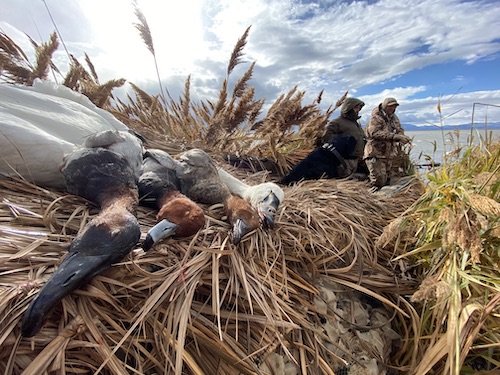
Unique Utah Airboat Green-winged Teal “Silhouette Hunt” on the Great Salt Lake
You’ll never see it anywhere else in the world. I promise you that.. We have these coffin blinds that we lay in. We throw out two to three hundred of those black duck silhouettes just to look like that wad of ducks that are sitting out there. We throw out about ten to fifteen dozen floaters out front, with some spinners, and lay there. You try to get as low-profile as you can, and they just come in and eat it up.
Ramsey Russell: Yesterday’s— Right about the time I think I’ve seen and done it all. We go out to two-inch deep water. There’s rafts of birds stretching for miles. Clouds of birds—as you’re driving out with those airboats—on that slick. Then y’all deployed one of the most unique systems I’ve ever seen. Just hand-cut, solid black silhouettes. An ocean of them. We just laid in them. I’m thinking, “Well, I guess this could work.”
Chad Yamane: You wouldn’t be the first person that said that. That is just, like I said, the traditional Utah airboat green-winged teal hunt on the Great Salt Lake. They’ve been doing it forever. It just flat out works. As you see, nothing grows out on the Great Salt Lake. It’s just too salty. It’s anywhere from two to six times saltier than the ocean. Nothing grows out there. There’s no vegetation, but there’s birds. And the birds just don’t have to get that high. The puddle ducks don’t play very well. We saw a bunch of puddle ducks, and they just don’t play well because they fly high. But the teal, the goldeneye, and the shovelers don’t. They have no reason to get high, and they stay low out there. They just work into it. You’ll never see it anywhere else in the world. I promise you that. It’s something you’ll never see. We roll out there. We have these coffin blinds that we lay in. We throw out two to three hundred of those black silhouettes just to look like that wad of birds that are sitting out there. We throw out about ten to fifteen dozen floaters out front, with some spinners, and lay there. You try to get as low-profile as you can, and they just come in and eat it up.
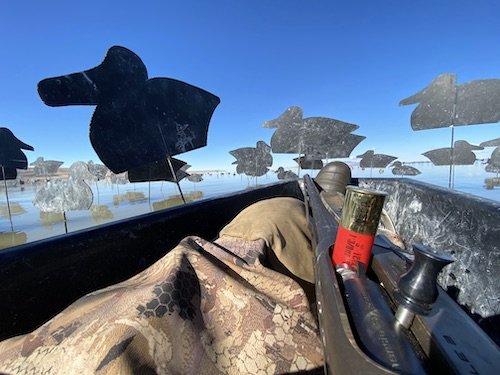
Ramsey Russell: Well, Big Ed was filming it. He was laying down with us, and it was funny looking back at him because those birds were coming in so low that he couldn’t see them.
Chad Yamane: He couldn’t see them. Yep.
Ramsey Russell: It was like talking to him in braille, trying to figure out what he needed to point his camera.
Chad Yamane: Yeah, to tell him exactly where everything was coming. Yep, that’s what they do.
Ramsey Russell: Was that a pretty typical shoot like that?
Chad Yamane: That’s a pretty typical shoot. Yeah, for sure.
Ramsey Russell: Because he was concerned. We were driving out to meet you that day, and it was broad sunlight. It had been shooting time for a couple of hours. He said, Man, what—” and I said, “No, no, no. Chad’s the real deal. He knows what he’s doing.” It was ice that morning, which is why I think you wanted to start up later.
Chad Yamane: Yeah, exactly. When it gets cold like that and ice on the pond, those teal— They’re a small bird. We keep them here up until our close in January. The teal are a hardy little bird, for teal. They stick and stay. When it gets cold, they’re just like you and me. They don’t want to get out there and move any more than they have to. They’ll hunker down, and they know. They know that the sun is going to come out, that it’s going to warm it up. It’s going to thaw their food source. The ice is going to be gone. We rolled into ice. We fought some ice. Then, hell, by the time we left, everything was damn near ice-free that afternoon. The birds had just really started moving when we were picking up. Which is what we like, we like to get out there—
Ramsey Russell: We probably finished setting up and getting the dogs in place and the airboats marked off—
Chad Yamane: It was after 11:00.
Ramsey Russell: Yeah. 11:30.
Chad Yamane: Yep, it was after 11:00.
Ramsey Russell: We were probably picking up around 1:30.
Chad Yamane: Yeah, so that’s kind of our typical— We don’t really try to jump in the airboat and head out until after the sun’s up and it’s kind of warming up, especially when we get into the late season. There’s been times where we’ll roll out at 3:00. The teal, it’s so cold there—it’s almost like a 3:00 flight there. It’s like a late-season goose hunt. When it’s colder, they’re going to feed once in the afternoon, and that’s it.
Ramsey Russell: What are the green-winged teal doing out there? Because last time I hunted with you, we hunted a part of the marsh that was, as far as the human eye could see, alkali bulrush. That was their principal food source at the time. What were they doing out here in this open water?
Chad Yamane: Yeah. They are switching their food source over to those brine shrimp eggs. The brine shrimp season, as far as their reproduction, is going on right now. Those brine shrimp eggs are floating up. It’s a high-protein little food source for them. There actually is a brine shrimp that is the only organism that lives in the Great Salt Lake. There’s a brine shrimp egg harvest that happens in November, December, January that is a multi-million dollar industry. They come in with big booms. They skim the top of the surface and pull those brine shrimp eggs off. They’re using it as a fish food because it’s so high-protein. It puts on the pounds on the fish. It’s a very valuable food source for fish. That’s what they’re doing. They’re buying it and then collecting it and then selling it to fish farms. That’s what the teal and the shovelers have figured out, that it’s a really good high-protein food source.
Ramsey Russell: Have you ever pulled a crop on those birds?
Chad Yamane: You don’t even have to. When they are on the brine shrimp eggs, when you shoot them—if you hold it upside down, it is literally spilling. It looks like sand. It’s like a grain of sand. It’s just spilling out of their mouths. Like a big old fat mallard coming off a cornfield.
Is Drought Affecting Utah Waterfowl Habitat
Ramsey Russell: Last question. You were telling me yesterday that it’s a drought. I couldn’t tell it, but I’m not as familiar with this area. It’s a drought, and you said there were some issues going on with fresh water coming into that part of the lake.
Chad Yamane: Yeah. We’re just in a really, really bad drought. We had a really bad summer. Not a great winter, last year. The lake’s in a really bad way right now. It’s as low as I can ever remember seeing it. Where we launched our airboat out of, we were only in a couple inches of water. If we don’t get some water, we’re going to be hurting bad. Yeah, we were what they call Farmington Bay. Antelope Island, which is out there where we were at, is now not even an island. There’s a land bridge that crosses in between Salt Lake and Antelope Island. The lake is so low. Basically, where we were at, if you would have tasted the water there would have been very little salt content. You wouldn’t have been able to taste probably any. That’s just because the water that’s flowing in right there is literally flowing out around the island. It’s almost a river, at this point, because the lake is so low. It flows out and then out into the main part of what we’d call the Great Salt Lake. Even though we were on the Great Salt Lake, you weren’t in very salty water yesterday.
Ramsey Russell: Last little topic because, listen folks, we’ve got folks piling in, and we have got fifteen or twenty great big old bam-bam steaks ready to go.
Chad Yamane: I’m looking forward to that.
Utah Trumpeter Swan Quota
Ramsey Russell: Oh yeah, me too, and I’m ready to finish my drink. Chad, real quickly—y’all can shoot trumpeter swans, but there’s a quota on it. Y’all are kind of racing the clock because the state can shoot so many, and so many have already been shot. DWR’s sending out emails.
Chad Yamane: Yeah. It used to be ten, up until last year. They actually pushed and got that raised to twenty. It’s our quota for trumpeter swans. So yeah, it’s not illegal to shoot a trumpeter. Mistakes are made, and the state understands that, so that’s why that’s in place. I really believed, after last year, that that was a freak occurrence. That we would never probably see that again in a lifetime. I think our bizarre weather patterns that we’re having— It’s hard to deny it. Montana again, North of us, had a really hard freeze that first week in November. They were not getting above the ‘teens. The waters froze up. Those trumpeter swans are pretty hardy birds, and, if they can find open water, they’ll stick and stay. I really think that, again, we had this big push of trumpeters again. We’re at like twelve. Someone said, today, that it may be possibly up to fourteen. Well, there’s nothing I can do about it. There’s nothing you can do about it. There’s nothing anyone can do about it. We’re just going to roll with it. If it shuts down, then it shuts down. A trumpeter is a true trophy. I would never frown on anyone for doing it. I understand why guys do it. I have targeted them in the past.
Differences Between Trumpeter Swans and Tundra Swans
Ramsey Russell: But you were saying the other day, it’s kind of hard, sometimes, to tell the difference between the two. It’s a big white bird.
Chad Yamane: Trumpeter swans are a lot quieter than tundra swans. Tundra swans, as you know and as you’ve heard over the last couple of days, are very vocal birds. They are really, extremely vocal. Everyone always says, “Oh, I just listen to them.” Trumps are pretty quiet birds. I shot one a couple years ago. I had no idea it was a trumpeter until after I pulled the trigger. The reason being is, they came in silent. There was a four pack of them. If they’re flying together, a five-pound difference on a bird, on a wing, is pretty hard to tell. Like I said, as soon as I pulled the trigger and the rest of the family group started making their call, immediately I knew what it was. But up until that point, I had no idea that I had shot one.
Ramsey Russell: What’s the difference in their sounds?
Chad Yamane: The tundra swan, or the whistling swan, has a high-pitched, yodel whistle. The trumpeter sounds like a kid picked up his toy trumpet and is just blowing away on it. It’s just a low, nasally trumpet noise. Literally, when you hear one, you’re like, “That’s a trumpet.” It sounds like someone blowing on a trumpet. Other than that, if it’s flying solo, you’d never know it was a trumpeter unless it was calling. If it’s flying with a flock of tundra swans, they are obvious, at that point, to pick out. They are that much bigger. But a single bird or a flock of them together, unless they’re vocal, is extremely tough.
Ramsey Russell: Chad, how can anybody listening get in touch with you?
Chad Yamane: You can check us out on our website, FriedFeathers.com. We’re on social media @FriedFeathersOutfitters. Facebook, Instagram, however they want. All our information is out there. We are not hard to find. You put Utah outfitter or Utah waterfowl guide into Google, and we’ll be the first one that pops up.
Ramsey Russell: Yep. Well, for all you guys that ask me who y’all should hunt with in Utah, this is your guy right here. Check him out. He and his partner, Rob Friedel, run a tight ship. Their boats are as clean as a fire engine. Detailed, organized, highly efficient, hard workers, and they put you on the birds. Thank y’all for listening to this episode of Duck Season Somewhere. We are fixing to finish our cocktails and start going and grilling some steaks. See you next time.




